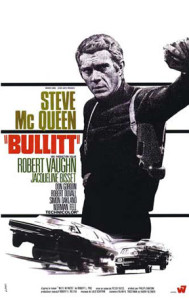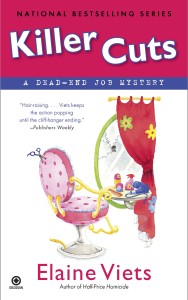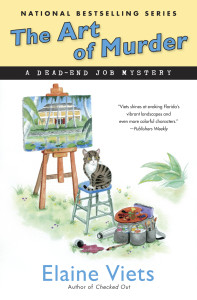By Elaine Viets
Dr. Gregory House is a creature of fiction. Real doctors aren’t that insensitive, are they?
Oh, yes they are. I had a brain surgeon who made Greg House look like Marcus Welby.
Dr. Jeb Travis Tritt is the brain surgeon who saved my life after I had six strokes, including a hemorrhagic stroke, in April 2007. That’s not his real name, and he doesn’t look or act like the brain surgeon in my new mystery Brain Storm. But Dr. Tritt, as I baptized him, was a real character. I couldn’t make up what he said – I’m not that creative.
 In fiction and reality, Dr. Tritt is a brilliant surgeon with a lousy bedside manner. He saws open skulls for a living, so I expected him to be a little strange. But hey, so am I.
In fiction and reality, Dr. Tritt is a brilliant surgeon with a lousy bedside manner. He saws open skulls for a living, so I expected him to be a little strange. But hey, so am I.
 Brain Storm, the first Angela Richman, Death Investigator novel, is set in mythical, ultrawealthy Chouteau Forest, Missouri. Angela and I had blinding headaches and other classic stroke symptoms that sent us to the ER. There we were misdiagnosed by the neurologist on call, who said we were “too young and fit to have a stroke.” This comment is staggeringly stupid, though I didn’t know it at the time. Babies can have strokes. Dr. I. M. Incompetent told Angela and me to come back in four days for a PET scan.
Brain Storm, the first Angela Richman, Death Investigator novel, is set in mythical, ultrawealthy Chouteau Forest, Missouri. Angela and I had blinding headaches and other classic stroke symptoms that sent us to the ER. There we were misdiagnosed by the neurologist on call, who said we were “too young and fit to have a stroke.” This comment is staggeringly stupid, though I didn’t know it at the time. Babies can have strokes. Dr. I. M. Incompetent told Angela and me to come back in four days for a PET scan.
 We never got that scan. Instead, we had a series of strokes, brain surgery, and a coma, and encountered Dr. Jeb Travis Tritt. After brain surgery, Angela and I were in a coma for a week and spent three months in the hospital.
We never got that scan. Instead, we had a series of strokes, brain surgery, and a coma, and encountered Dr. Jeb Travis Tritt. After brain surgery, Angela and I were in a coma for a week and spent three months in the hospital.
That’s where Angela and I parted company. When she came out of the coma, she learned that the doctor who nearly killed her had been murdered. The chief suspect was Dr. Tritt. Angela, still drugged and hallucinating, was determined to save the doctor who saved her. I can’t kill the doctor who misdiagnosed me. Except in fiction.
 But I did experience Dr. Tritt’s midnight monologues, and put them in Brain Storm.
But I did experience Dr. Tritt’s midnight monologues, and put them in Brain Storm.
When Dr. Tritt got off work at midnight, he’d stop by my room. First he’d check my healing wound – a hideous cobblestone of a bump. Then he’d settle in for a monologue, talking nonstop for two or three hours. I was a captive audience – I couldn’t walk yet. He’d make jaw-dropping comments. I was heavily drugged and still talking to imaginary friends. But I knew I had a real find. Dr. Tritt’s visits were a gift. It took me nine years to use it.
One night Dr. Tritt said, “Do you remember anyone talking to you while you were in a coma?”
“No,” I said. “No tunnel of light, no relatives waiting on the other side. I didn’t see or hear anything.”
“Thank God,” he said. “I used to stop by every night and say, ‘Elaine! This is God! Wake up!’ But the nurses made me quit.”
 Why did a surgeon spend hours talking to me instead of going home? He answered that question in another monologue.
Why did a surgeon spend hours talking to me instead of going home? He answered that question in another monologue.
“My wife is divorcing me,” he said. “She likes to shop and I don’t make enough money. She thought brain surgeons would be rich, but I don’t get that much. I only got three thousand dollars for your surgery. She wasn’t that good in bed, anyway. She just laid there, like you did, except you were in a coma.”
Huh? It didn’t occur to the doctor that perhaps his performance might have something to do with his wife’s lack of enthusiasm. The doc wasn’t coming onto me. My face was swollen, my skin was bright red thanks to an allergy to some medication, and half my hair was shaved off.
I’d always been proud of my long hair. I was shocked when I saw it had been partly shaved off for the surgery. Late one night, Dr. Tritt said, “I’m sorry about your hair.”
“In the grand scheme of things, it’s not the end of the world,” I said.
“I burned your hair because I knew you were going to make it,” he said. “If my patients are going to die, I save their hair because they like to look good in their coffins.”
 I was speechless. But then I thought: What would he say if I was going to die? Would he come by one midnight, hand me my hair and said, “Elaine, you’re screwed. But here’s your hair. You’ll look great in your coffin.”
I was speechless. But then I thought: What would he say if I was going to die? Would he come by one midnight, hand me my hair and said, “Elaine, you’re screwed. But here’s your hair. You’ll look great in your coffin.”
Good old Jeb Travis Tritt. This real life character saved my life. Now I hope he can help me pay off those hospital bills.
++++++++++++++++++++++++++++++++++++++++++++++++++++++++++
 Brain Storm is on sale as a trade paperback, audio and e-book amzn.to/2awPsIe
Brain Storm is on sale as a trade paperback, audio and e-book amzn.to/2awPsIe
Win an autographed hardcover of Elaine’s seventh Dead-End Job mystery, Clubbed to Death. http://elaineviets.com/index.php?id=contests













































